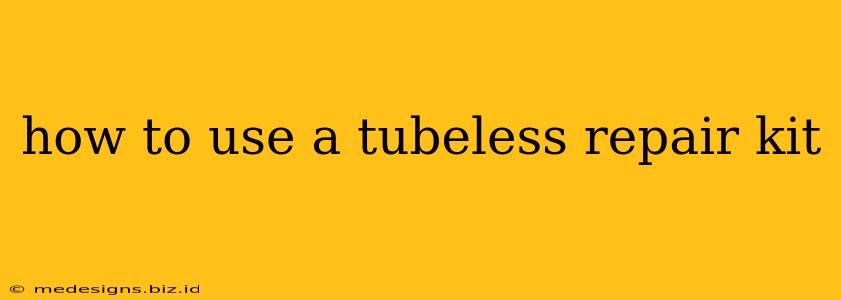So, you've got a flat tire, and you're relying on your tubeless repair kit to get you back on the road (or trail!). Don't panic! While it might seem daunting at first, repairing a tubeless tire is manageable with the right tools and technique. This guide will walk you through the process, step-by-step.
Assessing the Damage: Before You Start
Before you even think about pulling out your kit, take a moment to assess the situation.
- Locate the Puncture: Carefully inspect your tire, looking for any obvious signs of a puncture – a small hole, a protruding object, or escaping air. Sometimes, the leak might be subtle, requiring a closer examination.
- Check Air Pressure: If the tire is completely flat, it'll be easier to work with. However, if there's still some pressure, deflate it completely for easier access to the puncture.
- Clean the Area: Use a brush, rag, or compressed air to thoroughly clean the area surrounding the puncture. Removing any dirt, debris, or sealant residue is crucial for a successful repair.
Gathering Your Supplies: What You'll Need
A typical tubeless repair kit includes several essential components:
- Tire Plugs: These are the core of the repair, designed to seal the hole from the inside. They come in various sizes and materials (rubber, etc.).
- Reinsertion Tool: This tool helps to easily insert the tire plug into the puncture. Some kits include a needle-like tool, while others use a slightly larger, blunt-ended tool.
- Coarse Sandpaper or File: This is used to roughen up the edges of the puncture, improving adhesion for the plug. (You may not need this for smaller punctures.)
- Air Pump: You'll need a reliable pump to re-inflate your tire after the repair. A high-volume pump is ideal for quickly building pressure.
- Tubeless Sealant (Optional, but Recommended): While not always part of a basic kit, adding fresh sealant after a repair is highly recommended to prevent future punctures and seal any remaining small holes.
The Repair Process: Step-by-Step
Step 1: Prepare the Puncture
- Use the sandpaper or file (if necessary) to slightly roughen the area around the puncture. This creates a better surface for the plug to adhere to. Don't overdo it, just a light scuffing is sufficient.
Step 2: Insert the Plug
- Insert the insertion tool through the puncture hole, making sure to make a hole of roughly the same diameter of the plug.
- Attach the tire plug to the insertion tool.
- Carefully push the plug through the puncture from the inside of the tire to the outside. The insertion tool will pull the plug's tapered end through the hole, leaving the thicker end inside the tire.
- Push the plug all the way through until it's flush with the tire surface.
Step 3: Cut Off Excess Plug
- Use the insertion tool or scissors to cut off the excess plug material flush with the outer tire surface.
Step 4: Re-Inflate the Tire
- Use your air pump to inflate the tire to the recommended pressure. Watch carefully for any further leaks.
Step 5: Add Sealant (Optional but Highly Recommended)
- If your tire is still showing signs of leakage or you want added protection, inject fresh tubeless sealant to the tire through the valve. This will further seal small punctures and prevent future issues. Follow the sealant manufacturer's instructions for the appropriate amount of sealant to add.
Troubleshooting: Common Problems & Solutions
- Plug Won't Stay: The puncture might be too large, or the tire wasn't properly prepared. Try using a larger plug or more carefully roughening the area around the puncture.
- Air Leaking Around the Plug: The plug wasn't fully inserted, or the area around the plug wasn't clean. Ensure the plug is flush with the surface and remove any debris.
- Sealant Doesn't Work: The sealant might be old or expired. Use fresh sealant.
Maintaining Your Tubeless Setup: Proactive Prevention
Regularly checking your tire pressure and inspecting your tires for embedded objects will significantly reduce the likelihood of punctures. Consider adding a layer of tire liner for extra puncture resistance. With proper care, your tubeless setup will keep you riding smoothly.
By following these steps and taking preventative measures, you'll be well-equipped to handle tubeless tire repairs with confidence. Remember to practice on an old tire before attempting a repair on a crucial ride!
